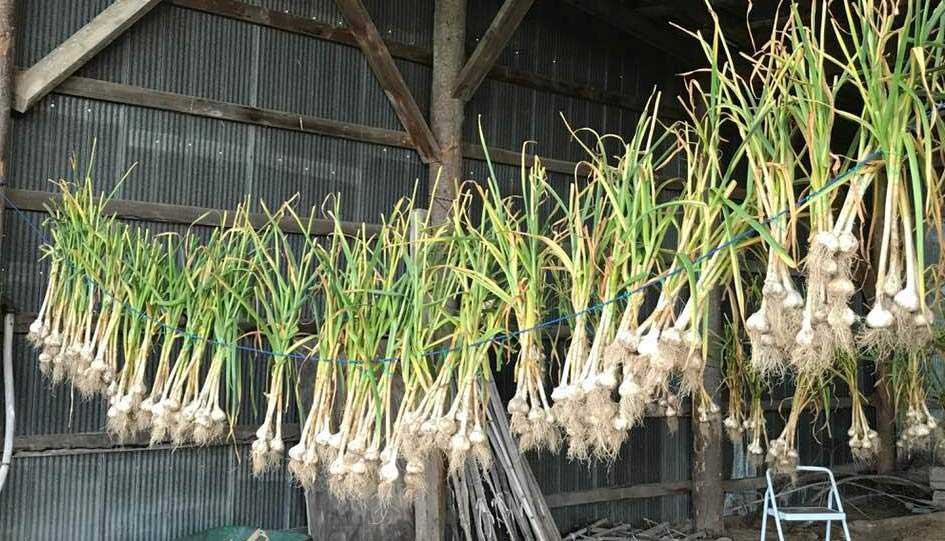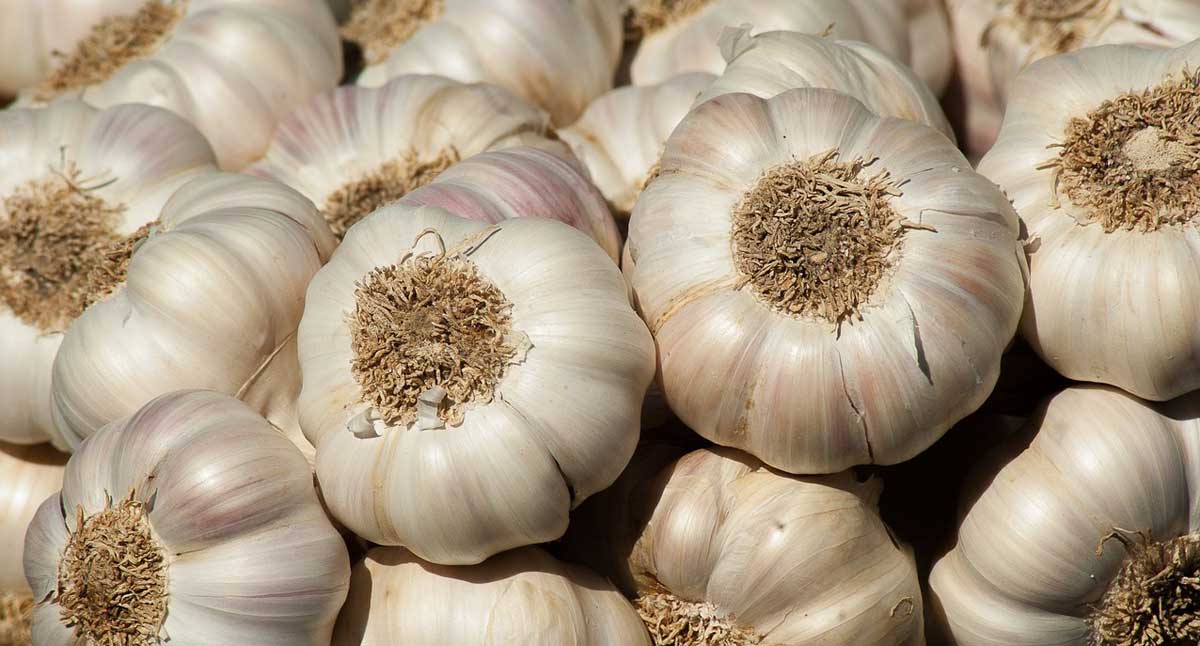Garlic (Allium sativum L.) is an important bulb crop grown and used as a spice or a condiment throughout India. It is also an important foreign exchange gaining crop for India. Garlic has a higher nutritive value than other bulb crops.
India exports fresh and chilled garlic, dried garlic, dehydrated garlic flakes, dehydrated garlic powder, and garlic oil to Bahrain, Bangladesh, Germany, Japan.
Garlic farming is mainly in Gujarat, Madhya Pradesh, Orissa, Maharashtra, Uttar Pradesh, and Rajasthan.
Soil for Garlic Farming
The Garlic crop grows in the well-drained loamy, rich in humus with fairly good potash content soil. Garlic Crops raised on sandy or loose soils have poor keeping quality, and the bulbs produced are lighter in weight.
Garlic Bulbs produced in heavy soils are deformed, and during harvest, many bulbs are broken and bruised. Bulbs become badly discolored, poorly-drained soil.
Acidic soils are not suitable for clove development. However, a pH range between 5 – 7 had little effect on growth and yield.
 Climate
Climate
Garlic crop grows under a wide range of climatic conditions. However, it cannot tolerate a climate that is too cold or too hot. It prefers medium temperature in summer as well as in winter.
Extremely hot or long dry periods are not favorable to bulb formation. It is a frost-hardy plant requiring a cool and moist period during growth and a relatively dry period during bulb maturity.
Garlic Bulbing formation takes place during long days and at high temperatures. An average temperature of 25-30°C is most helpful for bulb formation.
Garlic verity
These are high yielding and disease resistant garlic verity use in commercial Garlic cultivation.
Agrifound White, Yamuna Safed, Yamuna Safed 2, Yamuna Safed 3, Godavari, Shweta, GG-4, Phule Baswant, VL Garlic 1, VL Lahsun 2, Ooty 1, Agrifound Parvati, Agrifound Parvati 2.
Propagation

Garlic is propagated by planting cloves or bulbils or aerial bulbils.
Propagation by aerial bulbils is preferred when closer space is adopted. Aerial bulbils are more productive as compared to clones.
Larger cloves give a higher yield. The seed should be virus-free.
Season of Garlic planting:
The season of Garlic plantation is not similar to all over India.
- Maharashtra, Karnataka, and Andhra Pradesh – August to November.
- The northern state of India – September to November.
- Hilly areas, March – April. In
- West Bengal – November
Garlic Planting

The soil should be thoroughly prepared by repeated plowing, then add well-decomposed FYM at the rate of 10 to 20 tonnes per hectare.
The ideal spacing is 15 cm x 10 cm, and the seed rate 500 to 600 kg of cloves per hectare.
Three methods are available for garlic sowing.
- Dibbling
- Furrow planting
- Broadcasting.
When the close spacing has been adopted while garlic planting, the bulb’s size decreases, but the total yield increases; while broad space is adopted, the size of the bulb increases, but the total yield decreases.
Garlic responds well to organic manure so add Well decomposed FYM at the rate of 20 tonnes per hectare at the time of field preparation for garlic cultivation.
Nitrogen, phosphorus, potassium are applied at the rate of 60 kg each.
Nitrogen is given two split doses; one is when planting second is 30 days after planting.
The borax application at the rate of 10 kg/ ha is improving bulb size and crop yield.
Irrigation:
Before planting, the field should be given light irrigation. In garlic farming, furrow irrigation, drip irrigation, and sprinkler irrigation method are used.
Irrigation is repeated every 3rd during the initial stages. The crop is irrigated more frequently once in a week, but afterward, the crop irrigated once in 15
days.
The frequency is decreased, the crop is reached maturity the harvesting time the irrigation is stopped.
Intercultural Operations
Garlic is a closely planted crop; thus, manual weeding is tedious, expensive, and may cause damage the crop. Therefore, chemical herbicides like Linuron (2.25 kg/ha), Pendimethalin (1.5 kg/ha), and Tribunil (2.1 kg/ha) are useful.
Hoeing helps the crop just before the formation of bulbs loosens the soil and helps in a set of bigger and compact bulbs.
Harvesting
Garlic crop is ready for harvest in 130-150 days after planting, depending on cultivar, soil, and season.
At this stage, When the top turn yellowish and they show symptoms of drying and bending, we can recognize that the crop is ready for harvesting the crop.
Early harvest results in poor-quality bulbs that cannot be stored for long periods.
Bulbs are carefully lifted and clean, the leaves tied at the top shade dried in one week, and the bulbs are cured for proper drying for about 3 – 4 days in the shade for a maximum of one week before storage.
Yield
The garlic yield 40 to 100 quintals per hectare produce, depending on many factors like garlic variety, season, and soil fertility.
Storage of Garlic

Garlic is fairly cured in ordinary ventilated rooms; hence tied the Garlic leaves and hangs with support in well-ventilated rooms. Well-Cured garlic can store up to eight months at room temperature.




Dear Amar
Your comments have been quite helpful. I want to do integrated farming and though I have 5 acre land available with me for long lease, I would like to start on 1 acre.
I want to have Dairy withand would like to choose a crop to start with in polyhouse.
Plz help me with business plan and other details like subsidy in the state of jharkhand
Hello Vikash,
Our customer relations manager will get in touch with you shortly.
Amar I have 5 acres land with 2inches water help me in suitable craft
Hello Ranga,
Please contact our customer care 8788462787
Dear Sir,
Can I grow garlic in red sandy soil
Yes Rajiv, please test the soil before cultivation.
Hi! I am from Odisha. I have 6 acres of land and want to grow a very good variety of garlic. The soil is well suitable for garlic cultivation. Wants to have a technical guidance on garlic cultivation.
Hello Shaikh,
please call us our customer care number at 8788462787.
sir namaskar,
want to start agriculture as a business
at present doing business of solar power
please share me your address and phone number to discuss about this on professional basis .
I am Delhi based and want to do agriculture in u p
Hello Sanjay,
please call our customer care number 8788462787.